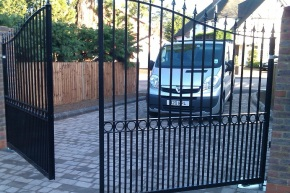Smart doors and gates are becoming more and more common as the smart home revolution builds momentum. It can be used for the control of shutters, blinds, heating, lighting, automatic gates and garage doors and many more systems.
Technology, devices, machinery and traditionally hand-operated items can be controlled in three distinct ways, manually, automatically and as part of a smart automation system.
If you have to open and close your gates or garage door by hand, then you get wet in the rain and cold in the winter.
Many manual gates can be left open during the day so that visitors can get in without having to open them by hand. But eventually gate are often left open all the time. This can cause hinges to rust and seize, and damaged hinges can let gates sag and drag along the ground.
Trying to close the gates when the owners go on holiday can be difficult. Ironically, closing gates that are normally left open can give burglars a sign that the homeowners are away.
Automating manual gates and garage doors allows you to open and close them at the touch of a button. Electric or hydraulic motors do the work and electronics keep things under control and as safe as possible.
You don't have to get out of your car, find the right key or get your hands wet and dirty.
Now, because they are normally closed, electric gates and garage doors also provide more security for you and your family.
The power supply is usually taken from the mains and 24Vdc systems can include battery back-up and/or solar charging for short term, emergency use.

• Remote Control
A remote control fob allows you to control your gates or garage door from a short distance. Simply press the appropriate button on your remote control and wait for your gates or garage door to open.

• Motors
Electric or hydraulic motors are usually used to open and close smart gates and doors.

• Access Control
Access control systems allow voice or voice and video communication between a gate and the house. A call panel at the gate has a button for calling the house, a speaker and a camera where video is included.
Some also have keypads, or readers for magnetic strip or chip cards or key fobs. These allow anyone with the code or registered card or fob to open the gate without having to call the house. Inside the house is a receiver, with a screen where video is included, and a button to open the gate remotely.

• Safety Sensors
Infrared sensors called photocells pass a beam of invisible light between them. If the beam is broken, they produce a signal that can stop the gate when someone passes into its path while it's moving.
Safety edges are sensors that detect contact with someone or something before stopping and reversing the gates.

Smart Doors and Gates
Once you automate gates, doors, shutters, lighting, heating or any of the facilities and technology in your home or business, you can incorporate these into a smart system. This allows multiple, automated devices to communicate with sensors and each other to provide increased security, comfort, energy savings, monitoring and management.
Most homeowners start with enhancing their home security by integrating their doors and gates into smart systems. Garage doors can open as you approach on foot without needing remote controls. Gates can instruct your garage door to open when they recognize that you are arriving home. Or they can close and lock your garage door when the gates tell them that you are leaving.
The following additions allow you to make your home a smart home:
Smart Home Hub
A central control hub co-ordinates everything including the stored programmed instructions, the communications brain and the smart system logic which tells something to carry out an action if something else happens first.
Bidirectional Feedback
All items in the smart system are in communication with the central hub both ways. That means that they receive instructions from it and tell it what they have done and what their status is, i.e. open or closed, on or off etc.
Sensors
Sensors detect the environment around devices to provide the trigger conditions and additional information for the smart hub’s brain. Adding motion detectors to heating and lighting control smart systems can help reduce energy costs. In larger homes and commercial properties, lighting, air-conditioning and other environmental controls can be turned down or off automatically where they are not needed.
With automatic gates and doors, sensors should already be in place to tell them when to open, close and stop or back off if someone is in their path as they’re moving.
Smart Home Communications
Wi-Fi, radio, wired and Mesh communications can be used in smart systems.
Smart System Security
As smart systems can be accessed through the internet if external monitoring and control is required, encrypted communications are used to prevent unauthorised use of your smart home controls.
Additional Monitoring and Control
Incorporating some devices into smart systems can require additional motors, sensors and controls. For example, curtains need motors to open and close them, mains-powered items like lights need additional control devices, and air filters need sensors to monitor the quality of the air.

Gate and Garage Door Costs
Gate automation kits include the essential items - a pair of remote control fobs, two motors, control panel, a pair of photocells and a manual release is typical for a double swing gate kit.
Kits can range in price from a few hundred pounds to over £1000. Access control systems and additional photocells and remote controls will add more to the final cost.
Similar motors are used for different types of garage doors but the hardware and access control may be slightly different.
Prices for a kit are around £300 to £400 for domestic garages while commercial door motors can be twice this price.
Automated Gate and Garage Door Costs
Gates can be made of various materials including wood, iron or steel, aluminium and even pvc. Good quality wooden ones can cost between £2000 and £4000 depending on size and type of wood. Aluminium is comparable in price while iron and steel may cost more. Good quality garage doors cost a few hundred pounds.
Installation
The complexity and therefore the cost of a new installation is determined by groundworks, electrical supplies, component choice, door or gate size and many other factors.
Prices can range from a few hundred pounds to a few thousand pounds.
Maintenance
Once electric gates or doors are installed and commissioned, they work like other machines so will need a schedule of regular maintenance.
Servicing cost has a lot to do with the frequency of use. Retail and industrial installations usually require the most maintenance followed by multi-occupancy flats and apartment buildings with single domestic properties needing the least maintenance.
A single maintenance visit can cost about £150.
Running costs
Running automatic smart gates or garage door doesn't use a lot in electricity.
The motors don't run for very long to complete one full cycle and to spend more than £20 a year running domestic systems is unusual.
Repairs
Maintenance helps reduce breakdowns but they can still happen and vandalism or accidental damage will also need repairing.
If a motor breaks down and needs replacing, repairs will usually be a few hundred pounds.
Replacing a remote control is much less expensive even though they need to be paired to your existing receiver.
Gate repairs can also be costly but unless you have wooden gates that rot away or iron gates that rust badly, gate repairs are usually only necessary if they are hit by a vehicle.
Smart Home Gate and Door Costs
For smart gates and doors, the initial cost covers installation, communications, programming and additional hardware to include any devices that are not already digitally controlled or are normally operated by hand. Wired systems will usually cost more to install than systems that communicate wirelessly.
The price will vary depending on what devices and systems are to be incorporated into your smart home system. But smart systems have the capacity to grow and include more and more devices, so you can start small and grow your smart system at your pace.




































1 Comment(s)
Looking for a front gate price
Leave a Comment